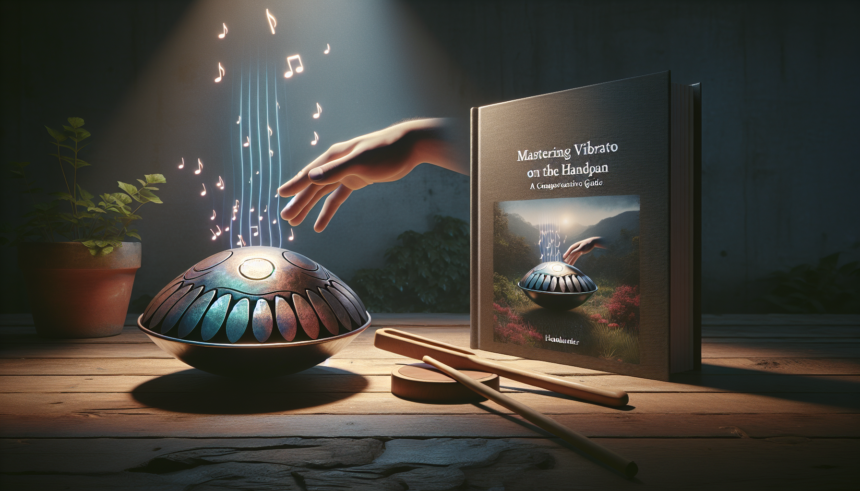The handpan, with its enchanting, ethereal sounds, has gained widespread popularity in recent years. One of the techniques that can take your handpan playing to the next level is vibrato. Often associated with instruments like the violin or voice, vibrato can add depth, emotion, and a sense of professional finesse to your handpan performance. This comprehensive guide will delve into the intricacies of mastering vibrato on the handpan.
Understanding Vibrato
Vibrato is a musical technique that involves a regular, pulsating change of pitch. It’s usually achieved through small, rapid fluctuations in pitch and provides a richer, more dynamic sound. In the context of handpan playing, vibrato can bring warmth, expressiveness, and a unique texture to each note.
The Importance of Vibrato in Handpan Music
Vibrato is more than just a decorative effect. When used correctly, it can enhance the emotional delivery of a piece, making the music more engaging and evocative. Applying vibrato appropriately requires a good sense of rhythm, timing, and restraint. Overuse or misuse can lead to a less effective performance, but when mastered, it can transform your music, adding a new dimension of sound.
Techniques for Mastering Vibrato
1. Finger Vibrato
The most common way to produce vibrato on the handpan is through finger movement. Here’s a step-by-step approach:
- Stabilize Your Hand: Start by placing your finger on the desired note. Keep your hand steady by anchoring it on the handpan.
- Small, Circular Motions: Move your finger in small, circular motions while keeping contact with the surface. These motions should be light and controlled.
- Pace and Consistency: The speed and consistency of the finger movement are crucial. Practicing with a metronome can help maintain a steady vibrato.
2. Hand and Wrist Vibrato
Another technique involves using the entire hand or wrist to create vibrato:
- Relax the Hand: Begin by relaxing your hand and wrist.
- Controlled Movement: Place your hand on the note and move your wrist in a stable, up-and-down motion. The movement should be gentle and even.
- Practice: Like finger vibrato, practice is essential. Start slow and gradually increase the speed as you become more comfortable.
3. Combining Techniques
Advanced players often use a combination of these techniques to create a more versatile and nuanced vibrato. Experiment with finger and wrist movements to see what works best for you and the piece you are playing.
Exercises to Improve Your Vibrato
1. Slow to Fast Transitions
Begin with slow vibrato movements and gradually increase the speed. This exercise helps you gain control over the tempo and consistency of your vibrato.
2. Metronome Practice
Using a metronome, practice vibrato at different tempos. This will help you keep a steady rhythm and integrate vibrato seamlessly into your playing.
3. Isolated Note Practice
Focus on one note at a time and apply vibrato. Isolated note practice allows you to concentrate on perfecting your technique without the distractions of a full piece.
4. Dynamic Variation
Practice applying vibrato with different dynamics (loud and soft playing). This will add expressiveness and variety to your music.
Common Challenges and Solutions
1. Inconsistent Vibrato
Solution: Slow down your practice and focus on maintaining an even tempo. Avoid rushing and concentrate on smooth, consistent movements.
2. Overuse of Vibrato
Solution: Integrate vibrato selectively. Use it to highlight specific parts of the music rather than applying it to every note.
3. Strain and Fatigue
Solution: Ensure your hand and wrist are relaxed. Take breaks and avoid excessive tension. Proper technique is essential to prevent strain.
Incorporating Vibrato into Your Music
Once you have mastered the basic techniques and exercises, you can begin incorporating vibrato into your music. Here are some tips:
- Listen to Experienced Players: Pay attention to recordings of skilled handpan players. Notice how they use vibrato and the effect it has on their music.
- Experiment with Different Styles: Try applying vibrato to different genres and styles of music to discover where it fits best.
- Use Vibrato Sparingly: Less is often more. Use vibrato to enhance certain notes or passages rather than overwhelming the music.
- Express Emotion: Use vibrato to convey the emotion of the piece. It should feel natural and match the mood of the music.
The Role of Practice and Patience
Like any musical skill, mastering vibrato on the handpan requires consistent practice and patience. Set aside dedicated practice time for vibrato exercises and be mindful of your progress. Celebrate small improvements and stay motivated by setting achievable goals.
Conclusion
Vibrato is a powerful tool that can enrich your handpan playing, adding depth and emotional resonance to your music. By understanding the techniques, practicing diligently, and incorporating vibrato thoughtfully into your performances, you can elevate your artistry and create truly captivating music. Remember, mastering vibrato takes time and patience, but the rewards are well worth the effort.
FAQs
1. How long does it take to master vibrato on the handpan?
The time required to master vibrato varies from person to person. With consistent practice, you can start seeing improvements within a few weeks. However, achieving a professional level of control and expression may take several months to a year.
2. Can vibrato be used on all handpan types?
Yes, vibrato can be used on most handpans, regardless of their scale or design. The technique might vary slightly depending on the specific instrument, but the fundamental principles remain the same.
3. How can I avoid overusing vibrato?
To avoid overusing vibrato, be mindful of when and where you apply it in your music. Use it to enhance specific notes or passages rather than applying it uniformly throughout the piece.
4. What should I do if my hand gets tired during vibrato practice?
If your hand gets tired, take a break and rest. Ensure that your technique is relaxed and free from excessive tension. Consistent, short practice sessions are more effective than long, strenuous ones.
5. Can vibrato be used in fast-paced pieces?
Yes, vibrato can be used in fast-paced pieces, but it requires precision and control. Practice applying quick, controlled vibrato movements and integrate them seamlessly into the tempo of the piece.





